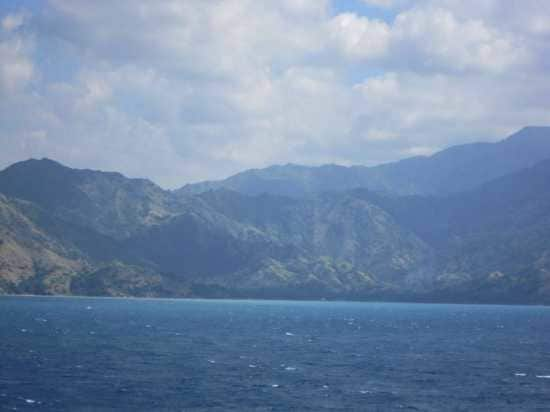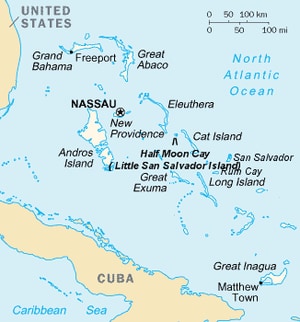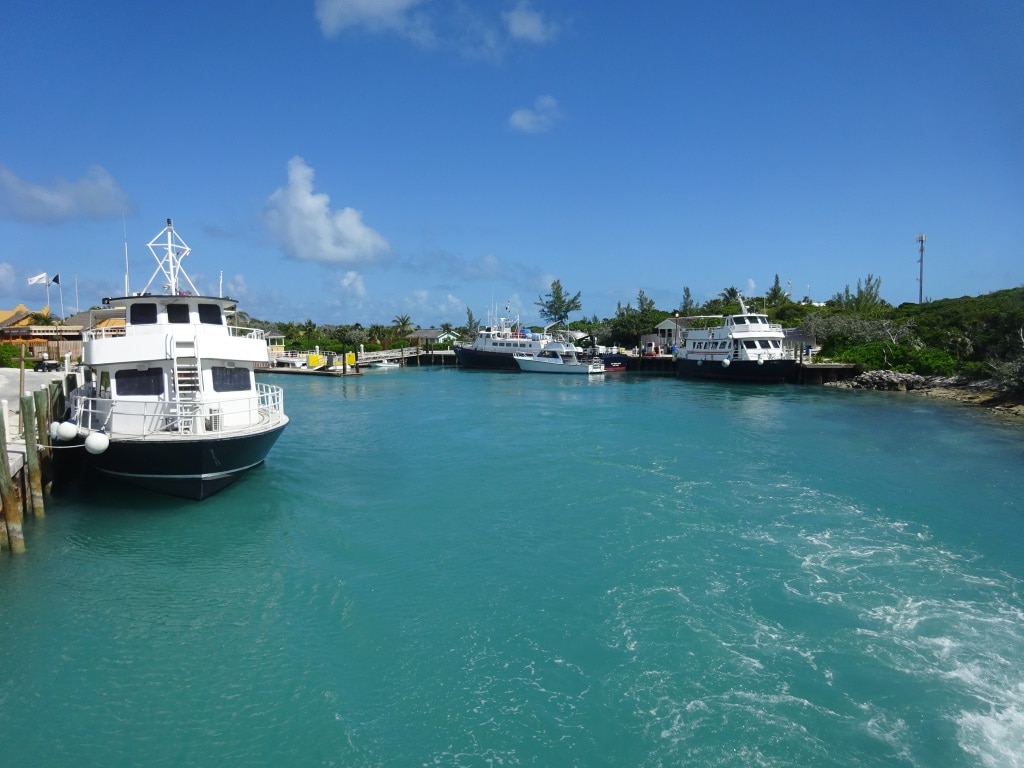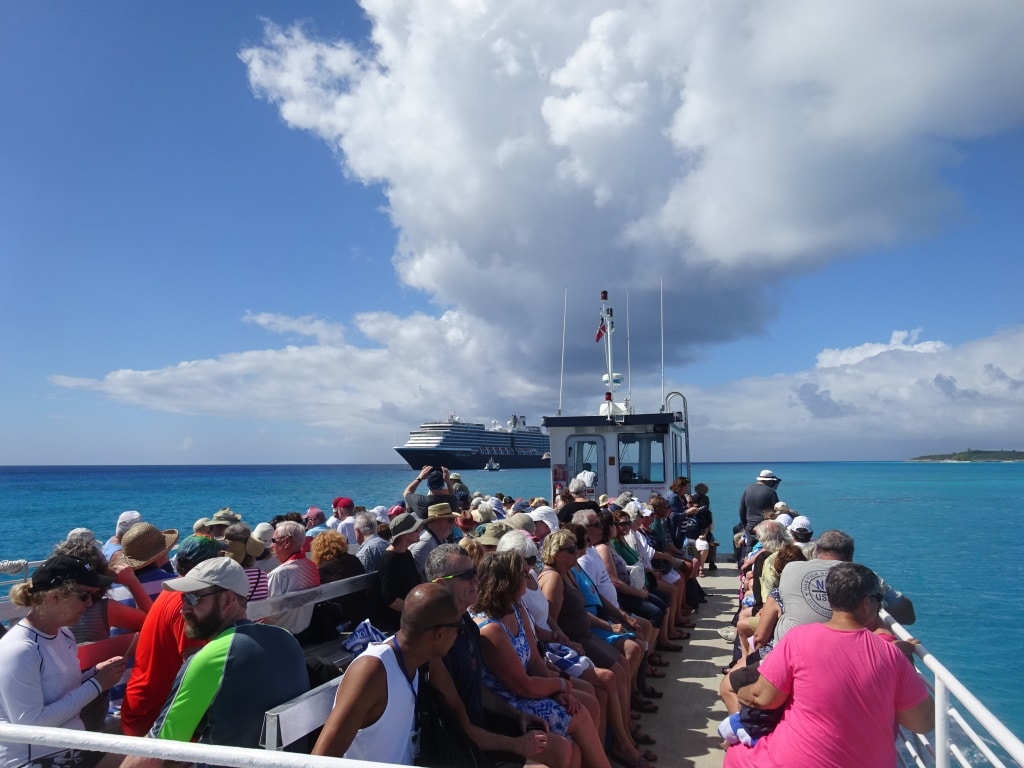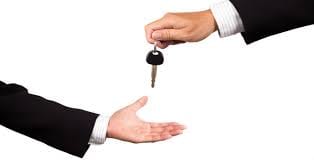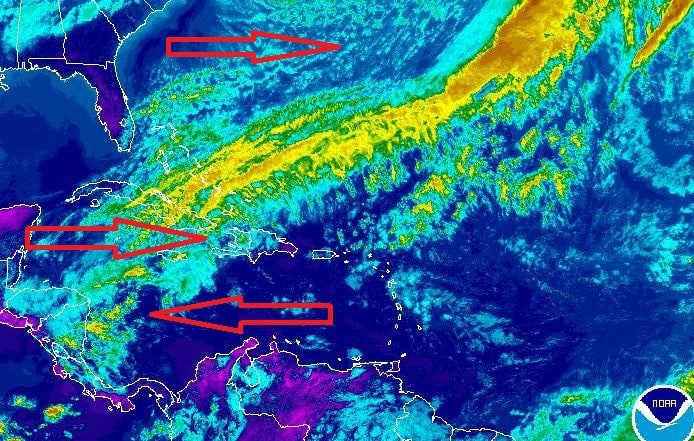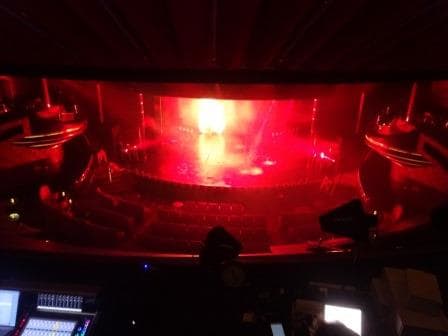Well this cruise started very well. The sea was as smooth as a mirror when we approached Half Moon Cay and the sun was happily shining with just a few clouds in the sky. I had been told that we would be the only ship here but when we arrived the Nieuw Amsterdam showed up as well. I should have checked myself as it is clearly on the sailing calendar. With two ships in there could be about 4000 guests ashore but in reality probably no more than 3000 as a lot of our guests have been there already a few times and opted to stay on board. And that means that the island is still very sparsely populated and there will be no fights over beach chairs. Continue reading
Category: Caribbean (page 8 of 13)
Today we had our first sea day with beautiful weather and it looks like it will remain so. The frontal system of yesterday dissipated and the next one coming will only bring thunderstorms on Monday and we will be in Ft. Lauderdale on Sunday. And that should be a warm day as normally between systems the wind dies down. The route we are taking runs roughly along the east coast of Costa Rica, Nicaragua, Guatemala and Mexico before we reach Cuba and the Straits of Florida. I use the word roughly as it is not a straight course. Continue reading
Puerto Limon is one of the two major ports in Costa Rica. There is a 3rd one Porto Moin but I have been told it is too obscure for cruise ships. One port is located on the west coast, Puerto Caldera with attached to it Punta Arenas cruise terminal and on the East coast there is Puerto Limon. Limon is not really much of a port. It is just a corner of a large bay with a cargo pier at the north side and a newer pier with two berths next to it. The cargo dock is lying inside the natural sea wall and that is not for nothing. The coast here is a real surfer’s paradise with swells that built up very high and then roll freely into the bay. Very exciting for surfers who come in droves to this coast to ride the waves. Continue reading
11 Feb. 2018: At Sea.
Yesterday I boarded the ms Zuiderdam in Willemstad after having been on vacation since December 18 after leaving the ms Nieuw Statendam when it ended its maiden voyage in Ft. Lauderdale.
During my vacation time, the IT gurus of Holland America have been moving my blog to a separate server for operational reasons. It should not have affected anybody as I am still linked through via the HAL blog but you can also reach me via www.captainalbert.com.
Never a dull moment when you work for Holland America. Continue reading
Happy faces all around on the bridge this morning; the wind had dropped below 15 knots and that gave no headaches for getting into Willemstad. If we are the only ship a Vista Class size will dock at the Mega Pier 1 or 2, outside of the port. But today there was also the Costa Magica and the Norwegian Dawn in and they are bigger so they went to the mega piers. Better for the blood pressure of the captain, less good for the guests as it is a much longer distance to walk to the town. A Vista Class size ship is about the maximum size ship that can go safely into the entrance and dock downtown. But as the cruise ships nowadays tower above the port and the houses, they also catch all the wind, and in the entrance there is not much room to drift. So there is a maximum wind you can allow for when going in.
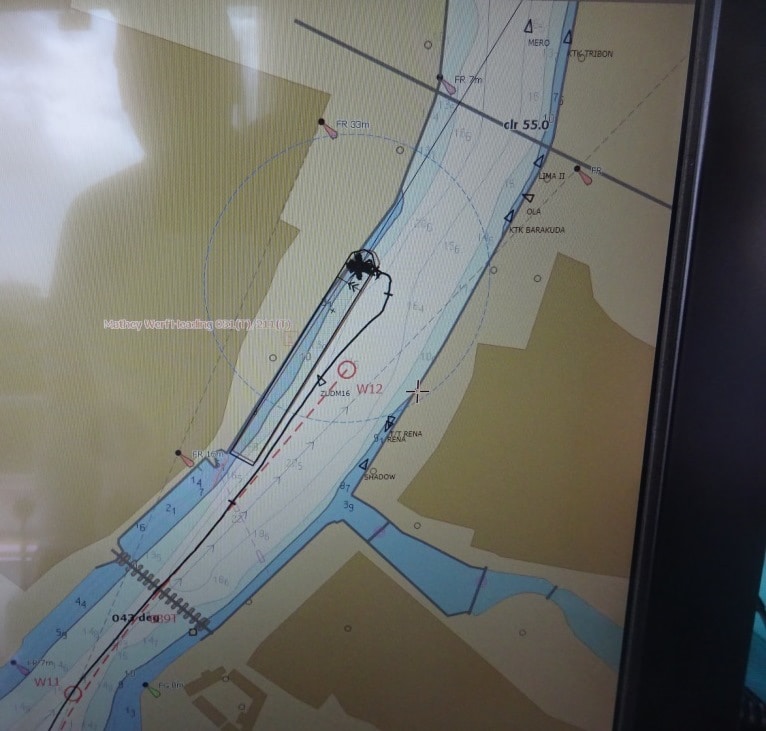
The red line is the optimum way in. You can see that we stayed almost perfectly on the line coming in. So the counter course against the current was good. Then almost at the dock, the ship was stopped with the bow heading towards the middle of the bay, and then the ship was moved over to the dock. The little dots on the lower left are the indications for the pontoon bridge, but we did not sail through them, the bridge opened on time.
Willemstad is a difficult port to start with anyway as there is normally a strong current running from East to West right under the entrance to the port which is called the St. Anna Baai. The deep water port behind it is called the Schotte Gat. Nice Dutch names. So you cannot sail under a straight line into it, you have to adjust for the set of the current. Today the current was not that strong but I have seen instances of up to 3 knots and then even the local pilots get nervous. But today the wind was reasonable and the current was reasonable and the Zuiderdam made it from pilot station to the dock within 10 minutes. If you have planned right, it is straight in, a course change to starboard, put the brakes on and go alongside. The challenge is not to hit anything while going in.
And there is always a lot of stuff around. Yachts and suppliers docked on the East side and on the West side there is the pontoon bridge which has to be opened to let ships in and out. The whole bridge is moved to one side and it makes the entrance somewhat smaller again. We cannot turn here. The bridge over the St.Anna Baai is too low for our class ship so tonight we will back out of the port as fast as possible. To counter act for the current we will go almost over to the East Side and then give full astern power and build up speed to about six knots. The faster we go, the less grip the current will get on the ship and the more clearance we will have left when the bow is moving out of the entrance as the last part of the ship.
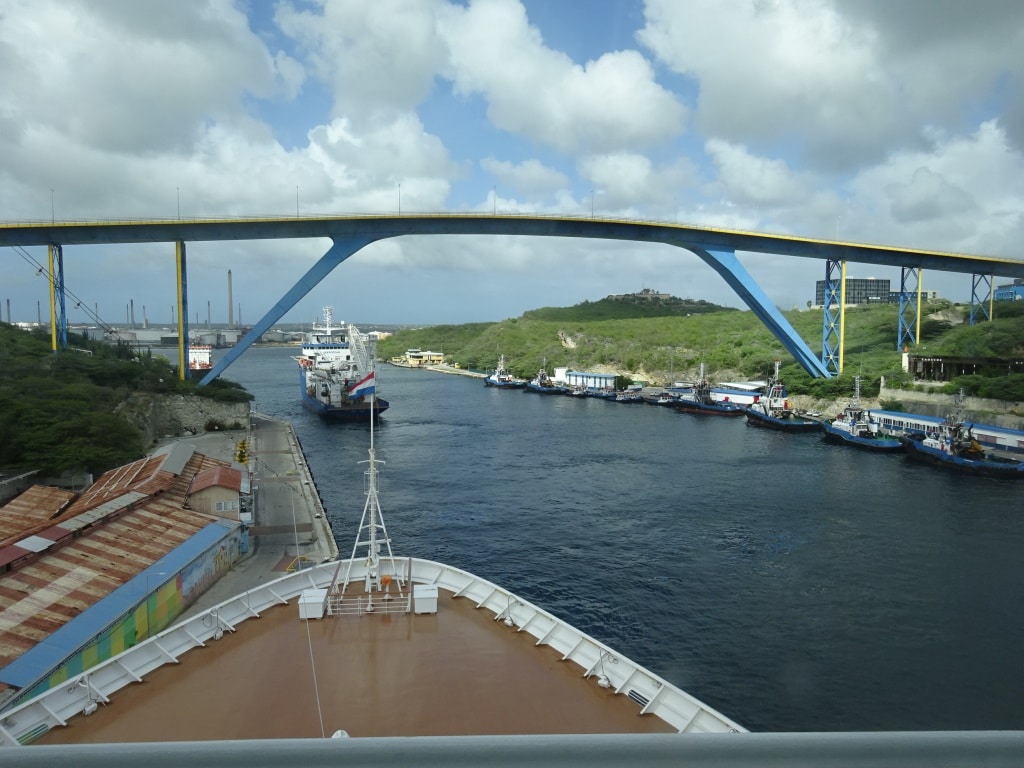
If this Koningin Juliana Bridge had not been there, we would have had a plan B; could have sailed all the way into the inner harbor, swing around there and come out again. But life is never perfect and as cars are not allowed on the pontoon bridge, they built this one. The ship seen under the bridge is a supply vessel for the oil rigs off the Venezuelan coast.
Because we cannot sail pass the dock here, due to the bridge, the captain does not really have a plan B. In Aruba yesterday we could go up to 35 knots and if it had not worked, we would have sailed out of the port again via the exit to the East. This plan B does not work in Willemstad so it has to work whatever your plans is and that means that the window of opportunity is a lot smaller as you can only do it with not too much wind.
Not that this bothered any of the guests. They all streamed out of the ship, walked over the Pontoon bridge right behind us straight into downtown. The unfortunate part was that there they found another 6000 eager shoppers from the two other ships. Most of our guests are repeaters, who have already been here before have bought the T shirt, and thus were back on board by lunch time. Willemstad is also a nice place to look at from the ship with all the brightly colored houses. I do not believe that there is any restriction on the choice of color, although a pilot told me last year that the local council frowned upon the use of florescent pink.
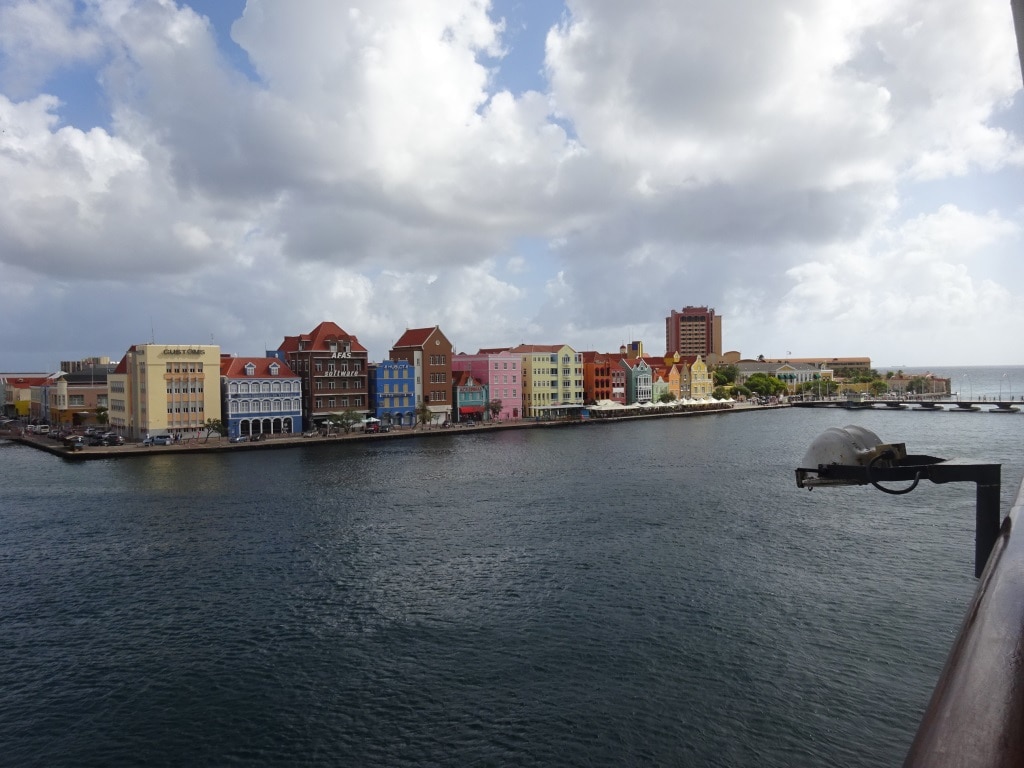
The colorful world of Willemstad. This is Punta, the main down town area. Then to the right we have the Koningin Emma pontoon bridge which leads to Otrabanda where the Zuiderdam is docked. That area is as colorful and was really re-developed with the money that the cruise business pumps into the Islands.
Tomorrow we are at sea; sailing north of Venezuela and later north of Colombia on our way to Cartagena. We will have wind and swell behind us so it should be pleasant on the deck. But we might have a bit of movement (every ship has the same problem in this part of the world) as the swell will catch the stern on the sb. quarter and that can result in a sort of corkscrew motion. And the stabilizers cannot do much about it as it is not really a rolling movement.
Today we had the first of one and half sea days to cover the distance between Half Moon Cay and Oranjestad in Aruba. Early this morning we sailed into the Windward Passage, the gap between the East point of Cuba and the West point of Hispaniola, or in the same way, between Cabo Maisi and Haiti. Then by noon time we cleared the Haitian coast and entered the Caribbean Sea. There was a lot of cloudiness obscuring the sun this morning and that spoiled the sail by near Haiti a little bit. If the sun can casts its rays un-obstructed into the sea then in this area you can see the sea bottom very clearly.
Sometimes to such an extent that it worries the guests who think that we are in very shallow waters. But we stay about 4 miles off the coast and the water is at least 60 to 100 feet deep under the keel on the route that we follow. But as the water is so clear and the bottom consists out of fine white sand, you can see the sandy sea bottom well over 60 feet down. I always tell guests who are asking about stabilizers on a day like this, to look over the side near lifeboat 7 and 8 when we are in this area, and then they can see them in operation. Not very exciting as it just looks like a stubby air plane wing painted in a red color. By they do their job and that is what it is all about.
I mentioned that the weather in Carib has been very boisterous in the last few days and although it has quieted considerably, the seas are still a bit confused. For a while a North Westerly wind had been blowing around here and now the regular trade wind is returning and is blowing the other way. Which causes the waves to come from two directions and result in a short wave / choppy sea.
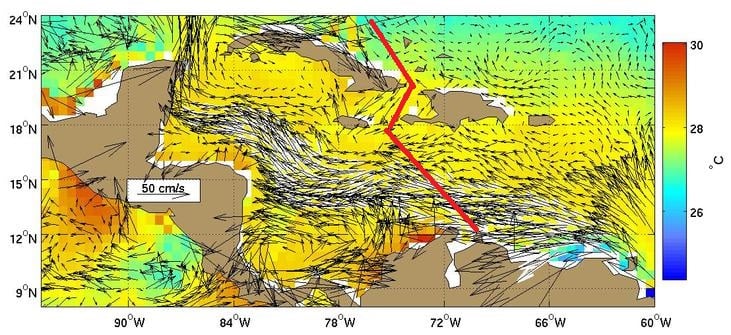
Our route into the Caribbean. The density of the arrows give the strength of the current. Problem is that it is never the same so you cannot rely on a diagram like this to get it completely right.
For this run, the captain really has to calculate the miles and the most advantageous courses to steer as we come across some opposite winds and currents. While sailing down from Half Moon Cay we have a small current against us, then before we enter the Windward Passage we get it on the beam and then when entering the Passage we can get up to 2 knots with us and sometimes a push from the wind as well.
Then while sailing off the Haitian coast there is nothing, but once we are clear we get the N.E current in the open Caribbean Sea generated by the Trade Winds. That current is in the beginning sort of with us and then later sort of against us as we are sailing on a South Easterly course. The art of navigating is to figure out roughly (Navigation is an art, not a pure science as we are dealing with the ever changing behavior of Mother Nature) what to expect in current velocity with us and against us and see if we can offset the one against each other. It is always satisfying to arrive at Aruba and to see that the ship had been able to maintain the average speed needed without having to change the engine configuration to catch up and to avoid being late.
So going from HMC until this evening we went faster than we needed on the average, but tonight we might go a little bit too slow, then late tomorrow morning we will pick up some current again and that altogether should bring us exactly on time at the Oranjestad Pilot station, by noon time. Sometimes Mother Nature is not predictable and then we have to adjust. Sometimes we go too fast (That is a bonus, as we save fuel) sometimes we go too slow and we have to give the ship an extra kick on the engines to compensate.
But with average weather and average sea conditions it quite often works out the way it is planned.
Tomorrow we have half a day at sea, and if the weather does what it is supposed to do (follow the weather forecast) then we should have a regular Caribbean Sea day. With the Trade wind blowing over the port bow and a regular low swell coming from the East. But whatever the weather, it will be warm. Even the rain if it falls.
Today the ship and thus all of us, spent the day at Half Moon Cay. We had a glorious day with partly cloudy skies and a gentle breeze. Perfect weather for a day at the beach…….. as long as you remember sun block 35. By late afternoon it became apparent that not all our guests had remembered that, most likely due to the cool breeze which made if feel a lot less “hot” than it was. They might remember Half Moon Cay for a few days to come.
It is tight run to get to Half Moon Cay on time from Fort Lauderdale, requiring a 19 knot average speed. It was even more tight than normal as we left later than scheduled as by departure time yesterday, we still had 26 unknown guests outstanding. Unknown means in this case, we did not know where they were as they were coming with their own transport so we could not keep track of them. We always wait if we can and we have the golden rule that if there are more than 10 outstanding, then we take the risk of maybe being a little bit late in the next port. So we sailed 40 minutes later and most of the “unknowns” had shown up by that time. And we just arrived on time at Half Moon Cay.
Holland America purchased a never ending lease for the larger part of Little San Salvador in 1996 and renamed it Half Moon Cay after the sailing ship of Henry Hudson (The Haelve Maen = Half Moon) which until recently was part of the company logo. Through the years the company has developed the area along the curved beach on the west side, keeping the rest of the island as a nature reserve. That is why there are no activities at the inner lake; we leave that to the local birdies.
So we arrived right just on time and dropped the hook in 10 meter deep water which left about 3 meters of clearance under the keel. More than enough water to float on. The water is so crystal clear here that we could see the anchor chain running all the way over the sea bottom. We had today about 1000 feet of chain in the water with the anchor itself hooked into the white sand bank in front of the port. Nice and safe and ship stayed where we parked it.
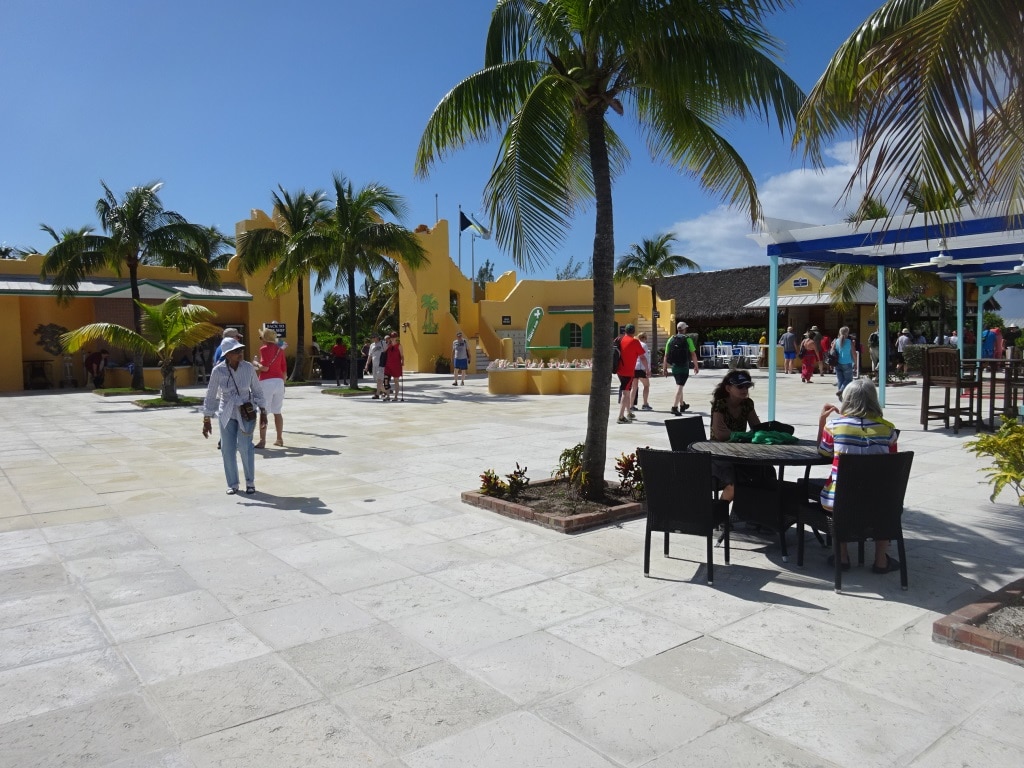
The main square is the first place you see when coming off the ship. It is surrounded by shops, The First Aid post and the Rum Runner Bar. The First Aid post seen here right across the square is manned by the ships medical officers.
We were the only ship in today and that meant we had the sole use of the shore tenders and that made transportation very easy. A few runs with the big tenders and the whole ship was empty. As all the facilities are running on the island, regardless of how many people there are on the island, the 1850 we brought ashore this time, had ample space and there were no lines. The island can easily handle 5000+ guests, which was put to the test some time ago when 2 Carnival Mega Liners called here on the same day. Carnival can use our island but only if there are no HAL ships. You will never see a HAL ship and a Carnival ship together. We do have sometimes two HAL ships at the anchorage together but as all our ships are medium size it is still not very crowded. (Except maybe at the Captain Morgan’s Bar, as drinking room there is somewhat limited as the bar is located inside the hull of an old sailing ship)
All food and drink is supplied by the ship itself; it goes ashore in the morning with a specialized boat called the Half Moon Clipper and on departure the left overs (very little) come back to the ship. Apart from some of the shops and the local sports activities, everything, including all the food and drink outlets are run by our own crew. Thus at the barbeque house you will see the same smiling faces as you see in the Lido every day. Still guests get confused sometimes and the remark of the day was: As I had free lunch here on the island can I still go back and have a free lunch on board????
On days like this you wish that you could stay overnight here with the ship. A night under the stars must be wonderful on the beach. But more ports are calling and so we had to leave at 15.00 hrs. to maintain the schedule and to arrive in Oranjestad, Aruba on time. And there we stay late in the evening so the guests can stay ashore longer.
We will sail this evening south through the Bahama Islands and then tomorrow morning dive into the Caribbean Sea by sailing through the Windward Passage. Weather at the moment looks good with little chance of turbulence.
The weather today is according to the weather forecast and thus everybody is happy. Very little wind to bother the ships arrival and nice and sunny during the day. At the terminal the temperature was even a few degrees lower than listed and that made for pleasant travel for the guests. Larger numbers always have to wait for the buses / coaches and it is never fun to sit in the roasting sun. Luckily Pier 26, the normal Holland America pier, is quite shaded on the East side. By the time disembarkation is in full swing the sun is still behind the terminal building and does not appear around the corner until well after 11 am. when disembarkation is over. For those coming the other way it is less of an issue and they can go directly into the cool terminal.
The ms Zuiderdam arrived a bit earlier than normal. If we are assigned at berth 21 or at 26 with nobody at 25/24 then the ship normally has the pilot at 06.15 hrs. Then it is docked by 06.45 and ready for business at 07.00hrs. Today the Celebrity Equinox was scheduled for berth 24/25 and thus the Zuiderdam was requested to arrive earlier. It saves sailing past the Equinox if she had come in first. There is enough room to do so but why make things difficult if there is an easy option. Captains like easy options as they are normally safer than difficult options; and so our pilot time brought forward to 05.30 hrs. And we arrived accordingly.
Today was also the changeover between Captain Bart Vaartjes and Captain Wouter van Hoogdalem. I was asked once in the past if this was a highly complicated and top secret evolution with the doors closed and reams of papers to be signed. None of that at all. The (electronic) paper work is limited to an entry in the ship log denoting that the handover has taken place and that is about it. The only other thing is a handover report in a checklist format. (There would be something wrong if we did not have one) The checklist is a standard form which all captains use, to ensure all pertinent issues are discussed. Then there is normally an attachment with “other items” and those normally have more focus than the regular list as “other” also means out of the usual. And I almost forgot there are about 10 pass words or so to hand over which lock all sorts of electronic devices, to avoid any electrons from escaping.
When two captains are rotating with each other, then a hand over is specified as having to last 4 hours. When nothing untoward has happened or is in the offing then 4 hours is more than sufficient with time to spare for gossip and multiple cups of coffee. If a regular rotation is not the case than we have other regulations. New function, New (class) ship. 14 days. So if a staff captain has been promoted and goes to another class ship that he (*) has been sailing on, then there will be handover of 14 days. If it is a new function, same class, or same function, different class, then there is a one week hand over period. This is also the case for other ranks.
The Zuiderdam is now going on a 10 day cruise, down to the South Caribbean and the Panama Canal. The only difference from the past 11 day cruise is that we will not call at Cartagena but go directly from Willemstad to Panama.
Thus our next call will be Half Moon Cay tomorrow as scheduled and we should make it as the weather is favorable. A new cold front is already forming, which draws the wind towards the north but at 15 knots it should not be a problem. Temperatures at noon time 75oC or 24oC. with a sunny day, just pleasant for a day at the beach.
(*) sorry to say but we still do not have a female captain. We were all keeping our fingers crossed as we had a female staff captain who was gaining sufficient seniority to approach promotion but she recently decided to go into pilotage in England. Bummer; now we have to wait a number of years again as the next female officers are all 2nd officers so they have some time to go.
Today we are having our first day at sea and are sailing on a North Westerly course heading towards the Yucatan Channel where the Caribbean Sea meets the Gulf of Mexico. It looks like that we were lucky with our call at Puerto Limon as the weather has turned for the worse. A strong cold front is moving over, bringing lots of rain, lots of wind and only an occasional moment of sunshine. And it is all moving in the direction of Costa Rica and thus the swell will start to increase again and will not make for a happy stay in the port for the ships arriving after us.
We really were in luck yesterday, because the moment we left the port, the heavens opened up over the City and the rain came down in large quantities. To maintain the rain forest, they will need that rain but our cruise guests do not exactly need it, and yesterday they were lucky. But today we have to face the weather and we are ploughing straight into it as well. The ship is making 20 knots, the wind velocity is 35 knots and on the exposed areas the combined relative wind reaches 50+ knots. So if you wanted to feel what a heavy storm feels like you would have to climb on the bow and do “a Titanic”. We do not want that so we keep the bow closed and on the higher decks we have wind screens.
It being winter means that cold front after cold front is coming over the area in a sort of washing machine pattern. Bad weather starts off at Cape Haterras where the cold air from the plains meets the warm air from the Gulf Stream. That gives a frontal system which moves to Europe or up to Iceland depending on how the Jet Stream flows. When that wind flows away, it creates a vacuum and that is filled by air coming from North Mexico into the Gulf of Mexico. That creates a vacuum and that is filled by air following opposite, following the regular Trade Wind route. On a sort of three day balance the directions move to and from which result in winter days of hot weather in Florida and days of cold weather.
Because things are quite forceful in the North Atlantic there is a strong weather front moving to the North East and thus also a strong counter flow under it. And we are right in the middle of it. The good thing is, we are moving, and our course is going right through it and thus we will emerge eventually at the other side of it. We expect that to happen when we come north of the Yucatan Peninsula which will be late tonight.
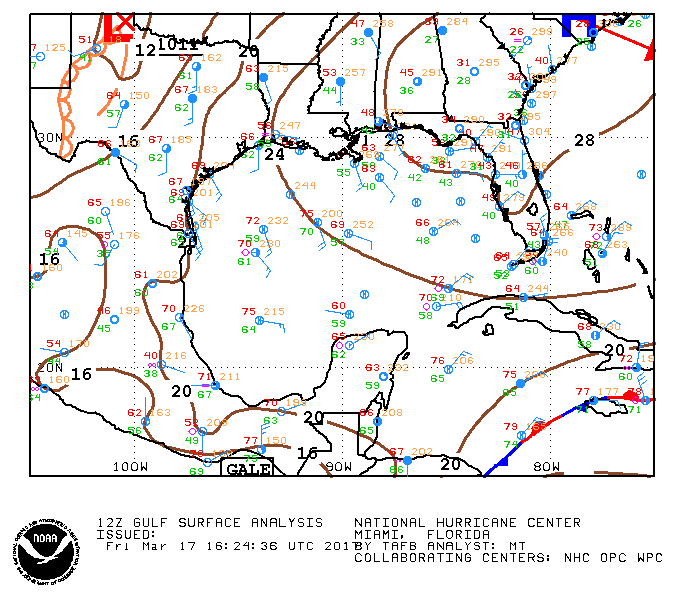
The Gulf of Mexivo. The blue red curve right under, laying over Grand Cayman indicates the edge of the frontal system. The blue arrows are wind. The word Gale at the mid bottom is the Tehantepec wind which is blowing very strongly at the moment.
That should bring the wind down from 35 knots to about 20 knots. And then for Sunday, when we are in Fort Lauderdale it should come down to 10 knots. In the meantime the seas which we are in are being pushed up by the winds and that makes the ship move a bit. Not rolling as the wind is nearly on the bow but more shuddering as the ship wants to pitch but does not know how to. Not that it has any effect on the guests, according to reports received, the bingo was well attended.
Courtesy of both pictures, NOAA. THANK YOU NOAA WHAT WOULD THE SEAFARING COMMUNITY AROUND NORTH AMERICA DO WITHOUT YOUR WEBSITES ??
Indeed the weather was with us today. Yesterday in the Canal the wind was already getting less and less and when we arrived this morning at the pilot station, there was no white cap to be seen. Just a little ripple indicating a wind force 1 to 2. That meant that during the night the waves had lost a lot of their height and strength and that made for a good day. Last cruise the swell had made it impossible for the ship to dock alongside the pier, this time there were no worries.
And thus the good ship Zuiderdam met a smiling pilot at 06.00 hrs. with only good news to bring and the ship sailed in at once. Puerto Limon is one of the more simpler ports to dock in (if there is no swell of course) it is just matter of sailing in and then deciding if you want to go portside alongside or starboard side. Starboard side is preferable as A. it takes less time to leave and B. if there is swell, the bow of the ship is better in dealing with it than the stern. The bow can ride on the waves and also cut them apart, but the stern being square, gets the wave every time under the square end. Then there is the danger that the swell will lift the ship up and start riding along the dock. Not good for the ropes and even worse for the gangway and the guests.
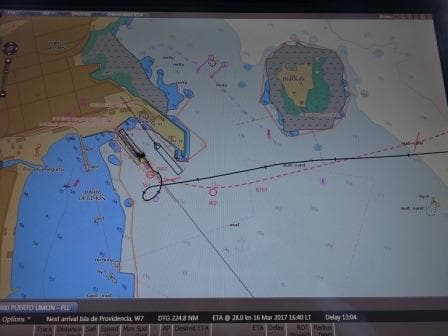
The approach according to the electronic chart. The black shape to the right is the Celebrity Equinox approaching the container berth.
Thus we swung on arrival and went astern alongside. Later on the Celebrity Equinox arrived and she went nose in. I think because she was on the late side. But today it did not really matter for her, what side was chosen.
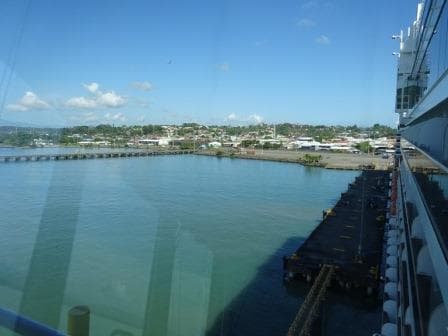
Puerto Limon as seen from starboard bridge wing. The country is low and flat, except for the middle part where there are high mountains.
Puerto Limon is a tour call for us as with the beautiful hinterland it is a great place for seeing wild life and the tropical rain forest. It is a country which is really trying to preserve nature and there are extensive nature reserves both on the Atlantic and the Pacific side. If you cruise on the Pacific Side then Holland America takes you to Golfo Dulce and Puerto Caldera /Punta Arenas where things are similar. Guests came back today with stories about having seen monkeys and “lots of noisy birds” so I assume the tours were a success.
I threw one of my specials today. Set the show lounge on fire and then have 30 or so casualties for Medical to try and save. We have an official disaster plan for this called the Mass Casualty Response Plan which provides guide lines of how too few doctors should try to save too many injured people. With a majority of entertainers as casualties (Natural Actors / and Actresses) there was enough mayhem created for the Medical Staff to be really focused and involved. A major part of the evolution is the transport away from the disaster area to a safe location where a second triage can take place and from where the the final disposition is organized. (Either back to the cabin, stay in the hospital or be medivac-ed ashore.
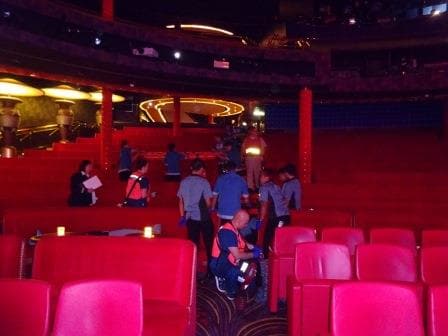
Doctor, Nurse, On Scene Commander, Stretcher Team and a Scribe for keeping track, all part of the machinery needed to make it possible.
My challenge is that I can only train on the flow of the drill and point out pitfalls to avoid. For the rest it all depends on the focus and organizational skills of the participating officers and crew. Today we had about a 100 crew involved varying from Fire teams, to wheel chair pushers and the very important stretcher carriers and casualties. Hardly any of the crew had ever done a drill like this, so the focus was there and so as long as you have that, then the drill is already a 50% success. Plus you do not always get the chance to run a drill in the main show lounge, which is the largest public room on board.
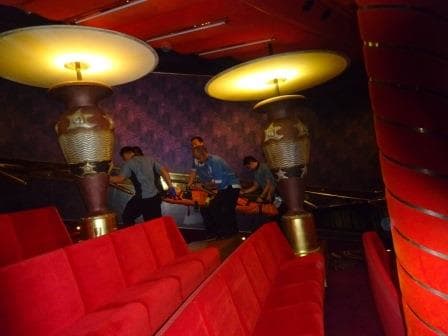
The Gents and Ladies from Housekeeping had a heavy job today, carrying stretchers up the stairs and then to the medical centers. But they did very well.
Tomorrow we have our first of two days at sea and then we are back in Fort Lauderdale. If things go according to the last plan, then I will remain a few more days on the Zuiderdam before transferring to the Westerdam. If the cabin situation works out I will train 6 new navigators for 14 days while the Westerdam sails to Europe.
Weather for tomorrow: wobbly but not too bad.
Note: Under the Current Captains section, the Biography of Zuiderdam captain Bart Vaartjes has now been uploaded and also the sailing schedules of the Captains has been updated.
© 2025 – Captain Albert's Website and Blog –
Theme by Anders Noren — Up ↑
